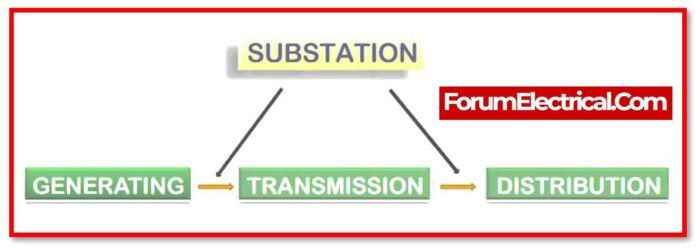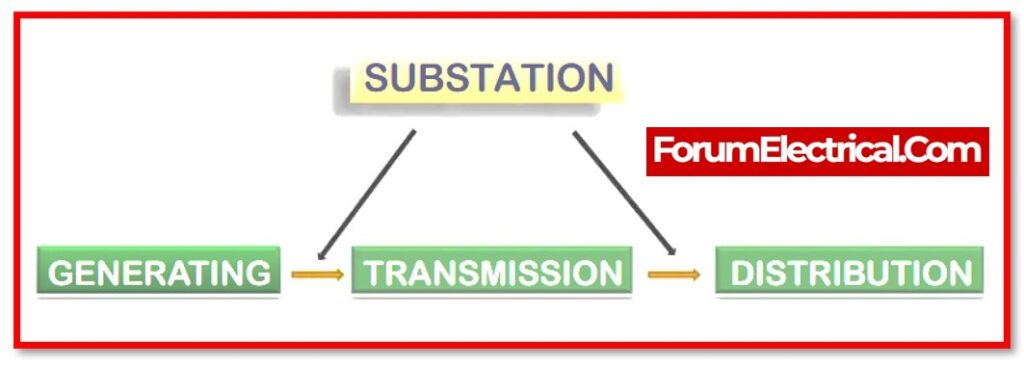- What is a Substation?
- An Electrical Substation’s Single-Line Diagram
- How does a substation operate?
- Primary functions of a Substation
- Location & site selection for a Substation
- Advantages of Substation
- Disadvantages of Substation
- What is grounding in a substation?
- What are reasons for the setting up of substations?
- Summary
What is a Substation?
The electrical substation is an essential part of a power system where voltage is changed for
- Switching,
- Distribution,
- Transformation, and
- Transmission
from high to low (or) low to high.
The primary parts of an electrical substation are
- A power transformer,
- A circuit breaker,
- A bus bar,
- An insulator, and
- A lightning arrester.
Electrical substations are essential to the efficient transmission of electricity across the grid (power system).
Electrical system is more than simply where power is generated or the connections that transport it to the houses and industries.
The electrical grid, in particular, is a smart network of specialized equipment that provides for the safe and efficient transmission & distribution of electricity.
Substations are essential components of the grid, allowing power to be safely and effectively transferred at various voltages.
An Electrical Substation’s Single-Line Diagram
The illustration below shows the substation’s single-line diagram.
The substation’s connection is classified into the following categories:
- Connection for an incoming or power feeder.
- Outgoing feeder for supplying switchgear or other upcoming substations.
- Connection to a power transformer.
- Connection to a voltage transformer for control & metering.
Each incoming & outgoing circuit is connected to the circuit breaker through the bus bar. There is an isolator available on every side of the circuit breaker.
The current transformer is employed for both measuring and protection. In order to overlap the protection zone and cover the circuit breaker, the current transformers (CT) are positioned on either side of the circuit breaker.
On the incoming line side and attached to the bus bar is the potential transformer. In order to prevent switching, lightning or surge arresters are connected in phase to ground at the incoming (input) line as the initial equipment, in addition to at the terminals of
- Transformers,
- Capacitor banks,
- Shunt reactors,
- Generators, and
- Large motors.
How does a substation operate?
The conversion of electricity into various voltages is one of the primary functions of substations. This is required so that power may be transferred throughout the surroundings and other structures.
Substations are equipped with the specialized machinery needed to change (or “switch”) the voltage of electricity. Transformers are parts of equipment that are located on the location of a substation and are used to step up or step down the voltage.
Electrical transformers use a fluctuating magnetic field to transmit electrical energy. They are made up of two or more wire coils, and the voltage change depends on how differently each coil wraps along its metallic core. This makes it possible to increase or decrease the voltage.
Depending on where the power is in its transmission path, substation transformers will serve different voltage conversion functions.
Primary functions of a Substation
Power substations in the distribution & transmission system are involved in a wide range of functions. The following are some of the main functions that substations carry out.
- It functions as the transmission system’s protective hub.
- It must manage load shedding while keeping the frequency of the system within specified parameters.
- It regulates the flow of electrical energy between generation and consumers.
- It provides both the system’s steady-state and transient stability.
- It ensures supply by delivering adequate line capacity.
- By limiting the flow of reactive power, it facilitates in establishing control over voltage.
- It transmits data via line carriers to ensure network monitoring, protection, and control.
- It helps in fault inquiries and identifying the root cause of a breakdown, enhancing the electrical network’s performance.
- It provides a steady supply through a network of feeding points at various locations.
- It helps with calculating energy transfer using transmission lines.
- Change the voltage such that it is at a different level.
- Change the voltage such that it is consistent despite the fluctuations in the system voltage.
- To connect and disconnect transmission & distribution circuits from the grid, will need to switch it.
- Take readings of the many types of electric power that are flowing through the circuits.
- Establish a connection between the communication signals and the circuits.
- Remove any potential sources of electrical surges from the system, including lightning.
- Establish connections between the system and the power plants.
- Establish connections between the power grids of many utilities so that power can be transmitted more quickly.
- Take control of the number of reactive kilovolt-amperes that are given to the circuits as well as the amount that are flowing through the circuits.
Location & site selection for a Substation
When choosing a location for a substation, the following must be taken into consideration.
1). Type of substation
For its position in the system, the substation’s category is important. A step-up transformer,
Ex: Location where electricity from multiple sources is combined, and step-up for long-distance transmission must be located as cold as possible to reduce losses.
To minimize transmission losses, the expense of the distribution system, and improve supply dependability, the step-down transformer must also be positioned closer to the load center.
2). Availability of sufficient and suitable land
Land should be level & open on all sides when choosing a location for a substation.
Particularly during the wet season, it shouldn’t be waterlogged.
The location of the substation should be chosen in a way that makes it easy and obstruction-free for transmission lines to approach and depart. Avoid locations near airports, gun ranges, and other such areas.
3). Possibility of communication
At a proposed station, both during & after construction, a functional communication facility is preferred.
Therefore, it is preferable to choose a location next to an existing road to make commuting simpler and more affordable.
4). Atmospheric pollution
- Air odours,
- Conductive dust, and
- Other pollutants
are produced in nearby areas of the underground factories. Furthermore, the area near the coast of a body of water may be more humid, which is detrimental to the efficient operation of the power system.
Therefore, the substation shouldn’t be placed close to factories or the seashore.
5). Access to essential facilities for staff
The location should allow for the provision of facilities for the staff, such as a school, hospital, access to drinking water, housing, etc.
6). Drainage facility
The location chosen for the proposed substations must have adequate drainage arrangements or the ability to implement effective drainage in order to prevent air pollution, the growth of microorganisms, and the deterioration of human health.
Advantages of Substation
- Increased capacity: By enabling the transfer of huge amounts of power across long distances, substations can boost the electrical grid’s capacity.
- Increased dependability: By enabling the isolation & repair of issues in certain system components, substations contribute to the electrical grid’s increased dependability.
- Enhanced safety: By lowering the possibility of electrical mishaps and fires, substations can contribute to an improvement in safety.
Disadvantages of Substation
- High cost: Establishing & maintaining a substation may be costly, particularly if additional transmission lines and land must be purchased.
- Environmental effects: Substations have the potential to damage wildlife habitats and have adverse environmental effects like noise and air pollution.
- Public opposition: Because of concerns about the new substation’s effects on the local environment & quality of life, certain neighbourhoods may be against its development.
What is grounding in a substation?
A standard return path for current, a reference point for measuring voltage, and a physical link between the body are all achieved through grounding.
A substation is a collection of numerous electrical devices. All of the machinery and the workers themselves must be secure even under unsafe conditions.
When an operational circuit comes into contact with an electrical device’s body, this is an adverse condition. The metallic enclosures potential increases over the ‘actual’ ground potential when a ground fault occurs in the equipment.
A correct grounding is required in all the circumstances mentioned above to prevent accidents. An inadequate grounding causes a higher potential or delays the fault’s clearance.
There are certain standards that serve as guidelines for substation grounding.
“IS 3043, IEEE 80 – According to specifications, earth mats are made using vertical ground rods and an earth mat that lowers the substation’s overall resistance to less than 1Ω. The substation is covered in the Earth mat. Two different earth flats are used to connect every component of equipment to the earth mat.”
Faster fault clearing & reduced enclosure potential rise are provided by an effective grounding plan.
In a similar manner, the lightning arrestor prevents equipment from being damaged by excessive voltage by capturing the high voltage (HV) discharged from clouds and directing it to earth using grounding flats.
What are reasons for the setting up of substations?
Reasons for setting up substations
Practical Considerations
For load Improvement: People or businesses moving to a new place without power supply infrastructure may want a substation nearby. Power lost as heat on distribution lines makes supplying this increased demand from distant substations inefficient.
To accommodate an increasing population: For constructing a wind farm (or) a solar farm, a collector substation will be required to connect all generators to the power grid.
To ensure reliability: Public entities construct new transmission lines to improve power system dependability. Operating the T-line at thermal capacity causes this shortcoming. To connect new transmission lines to substations, efforts are made. Sine, this is not feasible, so a new substation is constructed.
Technical Considerations
To increase or decrease AC voltage with transformers: Consider that increased voltages result in decreased currents. Decreased currents result in decreased copper losses.
V=I2R
Thus, more energy is available for productive work. At the end of distribution, voltages must be stepped down for customer use.
Substations provide the space required for setting up a transformer for the transmission and distribution of electricity.
Breaking power flow: A fault (such a tree impacting a live wire) often necessitates line isolation until the issue is fixed. Simply adding switches to the line won’t stop electricity flow. To securely interrupt thousands of amperes, require circuit breakers with enormous current capacities. Most substations have circuit breakers that trip & isolate transmission lines.
Provide power flow support: Despite DC power flow, AC power flow must overcome both resistive and inductive impedance from equipment such motor loads, transmission lines, reactors, etc. Substations include capacitor banks on all three phases of lines to simplify power flow. It also boosts electrical system power factor.
Summary
The purpose of a substation in an electrical power grid is to function as an important intermediary point, which helps to ensure that electricity is transmitted, distributed, & controlled in an efficient and dependable way. It is extremely important in ensuring the reliability and high standard of the electrical power supply that is delivered to end users.













